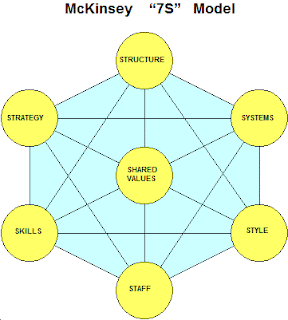A
marketing plan may be part of an overall business plan.
Solid marketing strategy is the foundation of a well-written marketing plan. While a marketing plan contains a list of actions, a marketing plan without a sound strategic foundation is of little use.
Marketing process can be realized by the marketing mix in step 4. The last step in the process is the marketing controlling. In most organizations, "strategic planning" is an annual process, typically covering just the year ahead. Occasionally, a few organizations may look at a practical plan which stretches three or more years ahead.
To be most effective, the plan has to be formalized, usually in written form, as a formal "marketing plan." The essence of the process is that it moves from the general to the specific, from the vision to the mission to the goals to the corporate objectives of the organization, then down to the individual action plans for each part of the marketing program. It is also an interactive process, so that the draft output of each stage is checked to see what impact it has on the earlier stages, and is amended
Behind the corporate objectives, which in themselves offer the main context for the marketing plan, will lie the "corporate mission," which in turn provides the context for these corporate objectives. In a sales-oriented organization, the marketing planning function designs incentive pay plans to not only motivate and reward frontline staff fairly but also to align marketing activities with corporate mission.
This "corporate mission" can be thought of as a definition of what the organization is, of what it does: "Our business is …". This definition should not be too narrow, or it will constrict the development of the organization; a too rigorous concentration on the view that "We are in the business of making meat-scales," as IBM was during the early 1900s, might have limited its subsequent development into other areas. On the other hand, it should not be too wide or it will become meaningless; "We want to make a profit" is not too helpful in developing specific plans.
Abell suggested that the definition should cover three dimensions: "customer groups" to be served, "customer needs" to be served, and "technologies" to be used . Thus, the definition of IBM's "corporate mission" in the 1940s might well have been: "We are in the business of handling accounting information [customer need] for the larger US organizations by means of punched cards
Perhaps the most important factor in successful marketing is the "corporate vision." Surprisingly, it is largely neglected by marketing textbooks, although not by the popular exponents of corporate strategy - indeed, it was perhaps the main theme of the book by Peters and Waterman, in the form of their "Superordinate Goals." "In Search of Excellence" said: "Nothing drives progress like the imagination. The idea precedes the deed." If the organization in general, and its chief executive in particular, has a strong vision of where its future lies, then there is a good chance that the organization will achieve a strong position in its markets (and attain that future). This will be not least because its strategies will be consistent and will be supported by its staff at all levels. In this context, all of IBM's marketing activities were underpinned by its philosophy of "customer service," a vision originally promoted by the charismatic Watson dynasty. The emphasis at this stage is on obtaining a complete and accurate picture.
A "traditional" - albeit product-based - format for a "brand reference book" (or, indeed, a "marketing facts book") was suggested by Godley more than three decades ago:
- Financial data—Facts for this section will come from management accounting, costing and finance sections.
- Product data—From production, research and development.
- Sales and distribution data - Sales, packaging, distribution sections.
- Advertising, sales promotion, merchandising data - Information from these departments.
- Market data and miscellany - From market research, who would in most cases act as a source for this information. His sources of data, however, assume the resources of a very large organization. In most organizations they would be obtained from a much smaller set of people (and not a few of them would be generated by the marketing manager alone).
It is apparent that a marketing audit can be a complex process, but the aim is simple:
"it is only to identify those existing (external and internal) factors which will have a significant impact on the future plans of the company." It is clear that the
basic material to be input to the marketing audit should be comprehensive.
Accordingly, the best approach is to accumulate this material continuously, as and when it becomes available; since this avoids the otherwise heavy workload involved in collecting it as part of the regular, typically annual, planning process itself - when time is usually at a premium.
Even so, the first task of this
annual process should be to check that the material held in the current
facts book or
facts files actually
is comprehensive and accurate, and can form a sound basis for the marketing audit itself.
The structure of the facts book will be designed to match the specific needs of the organization, but one simple format - suggested by Malcolm McDonald - may be applicable in many cases. This splits the material into three groups:
- Review of the marketing environment. A study of the organization's markets, customers, competitors and the overall economic, political, cultural and technical environment; covering developing trends, as well as the current situation.
- Review of the detailed marketing activity. A study of the company's marketing mix; in terms of the 7 Ps - (see below)
- Review of the marketing system. A study of the marketing organization, marketing research systems and the current marketing objectives and strategies. The last of these is too frequently ignored. The marketing system itself needs to be regularly questioned, because the validity of the whole marketing plan is reliant upon the accuracy of the input from this system, and `garbage in, garbage out' applies with a vengeance.
- Portfolio planning. In addition, the coordinated planning of the individual products and services can contribute towards the balanced portfolio.
- 80:20 rule. To achieve the maximum impact, the marketing plan must be clear, concise and simple. It needs to concentrate on the 20 percent of products or services, and on the 20 percent of customers, that will account for 80 percent of the volume and 80 percent of the profit.
- 7 Ps: Product, Place, Price and Promotion, Physical Environment, People, Process. The 7 Ps can sometimes divert attention from the customer, but the framework they offer can be very useful in building the action plans.
It is only at this stage (of deciding the marketing objectives) that the active part of the marketing planning process begins. This next stage in marketing planning is indeed the key to the whole marketing process.
The "marketing objectives" state just where the company intends to be at some specific time in the future.
James Quinn succinctly defined objectives in general as:
Goals (or objectives) state what is to be achieved and when results are to be accomplished, but they do not state "how" the results are to be achieved.They typically relate to what products (or services) will be where in what markets (and must be realistically based on customer behavior in those markets). They are essentially about the match between those "products" and "markets." Objectives for pricing, distribution, advertising and so on are at a lower level, and should not be confused with marketing objectives. They are part of the marketing strategy needed to achieve marketing objectives. To be most effective, objectives should be capable of measurement and therefore "quantifiable." This measurement may be in terms of sales volume, money value, market share, percentage penetration of distribution outlets and so on. An example of such a measurable marketing objective might be "to enter the market with product Y and capture 10 percent of the market by value within one year." As it is quantified it can, within limits, be unequivocally monitored, and corrective action taken as necessary.
The marketing objectives must usually be based, above all, on the organization's financial objectives; converting these financial measurements into the related marketing measurements.He went on to explain his view of the role of "policies," with which strategy is most often confused: "Policies are rules or guidelines that express the 'limits' within which action should occur."Simplifying somewhat, marketing strategies can be seen as the means, or "game plan," by which marketing objectives will be achieved and, in the framework that we have chosen to use, are generally concerned with the 8 P's. Examples are:
- Price - The amount of money needed to buy products
- Product - The actual product
- Promotion (advertising)- Getting the product known
- Placement - Where the product is located
- People - Represent the business
- Physical environment - The ambiance, mood, or tone of the environment
- Process - How do people obtain your product
- Packaging - How the product will be protected
(Note: At GCSE the 4 Ps are Place, Promotion, Product and Price and the "secret" 5th P is Packaging, but which applies only to physical products, not services usually, and mostly those sold to individual consumers)
In principle, these strategies describe how the objectives will be achieved. The 7 Ps are a useful framework for deciding how the company's resources will be manipulated (strategically) to achieve the objectives. However, they are not the only framework, and may divert attention from the real issues. The focus of the strategies must be the objectives to be achieved - not the process of planning itself. Only if it fits the needs of these objectives should you choose, as we have done, to use the framework of the 7 Ps.
The strategy statement can take the form of a purely verbal description of the strategic options which have been chosen. Alternatively, and perhaps more positively, it might include a structured list of the major options chosen.
One aspect of strategy which is often overlooked is that of "timing." Exactly when it is the best time for each element of the strategy to be implemented is often critical. Taking the right action at the wrong time can sometimes be almost as bad as taking the wrong action at the right time. Timing is, therefore, an essential part of any plan; and should normally appear as a schedule of planned activities.Having completed this crucial stage of the planning process, you will need to re-check the feasibility of your objectives and strategies in terms of the market share, sales, costs, profits and so on which these demand in practice. As in the rest of the marketing discipline, you will need to employ judgment, experience, market research or anything else which helps you to look at your conclusions from all possible angles.
At this stage,you will need to develop your overall marketing strategies into detailed plans and program. Although these detailed plans may cover each of the 7 Ps (marketing mix), the focus will vary, depending upon your organization's specific strategies. A product-oriented company will focus its plans for the 7 Ps around each of its products. A market or geographically oriented company will concentrate on each market or geographical area. Each will base its plans upon the detailed needs of its customers, and on the strategies chosen to satisfy these needs. Brochures and Websites are used effectively.
Again, the most important element is, indeed, that of the detailed plans, which spell out exactly what programs and individual activities will take place over the period of the plan (usually over the next year). Without these specified - and preferably quantified - activities the plan cannot be monitored, even in terms of success in meeting its objectives.It is these programs and activities which will then constitute the "marketing" of the organization over the period. As a result, these detailed marketing programs are the most important, practical outcome of the whole planning process. These plans must therefore be:
- Clear - They should be an unambiguous statement of 'exactly' what is to be done.
- Quantified - The predicted outcome of each activity should be, as far as possible, quantified, so that its performance can be monitored.
- Focused - The temptation to proliferate activities beyond the numbers which can be realistically controlled should be avoided. The 80:20 Rule applies in this context too.
- Realistic - They should be achievable.
- Agreed - Those who are to implement them should be committed to them, and agree that they are achievable. The resulting plans should become a working document which will guide the campaigns taking place throughout the organization over the period of the plan. If the marketing plan is to work, every exception to it (throughout the year) must be questioned; and the lessons learnt, to be incorporated in the next year's .



